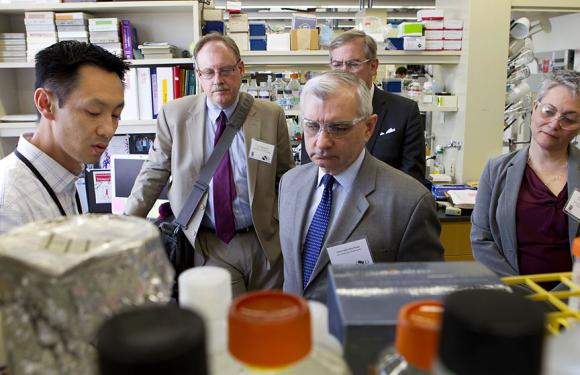PROVIDENCE, R.I. [Brown University] — U.S. Sen. Jack Reed (D-RI), the New England regional administrator of the U.S. Environmental Protection Agency, and the directors of the state departments of Environmental Management and Health, visited Brown University’s Superfund Research Program Monday, April 9. 2012. The Brown lab is one of 14 research groups funded by the National Institutes of Health to assess and remediate Superfund sites nationwide.
Brown’s Superfund research group has been in operation since 2005. The program has brought in some $43 million in funding to Rhode Island since then, creating or supporting 45 jobs in the Ocean State. The group is working on the Centredale Manor Superfund site in Providence, the Gorham Manufacturing site in Providence, and the well-publicized soil contamination affecting residential properties in the Bay Street neighborhood in Tiverton. In these cases, scientists and students have tracked the flow of hazardous gases from contaminated sites, identified and tested toxic chemicals, worked with community and neighborhood associations and state and federal agencies to clean up contaminated areas, and offered insights into how chemicals can alter human health and reproduction.
“Rhode Island is a small, densely populated state with a proud industrial heritage, yet burdened by a toxic legacy,” said Kim Boekelheide, professor of medical science and a member of Brown’s Superfund research group. “Brown’s Superfund Research Program is a center of technical excellence, where we focus on new scientific approaches to clean up our post-industrial legacy of contaminated sites here in the Ocean State and throughout the nation.”
Reed toured the Brown group’s facility in the Laboratories for Molecular Medicine, 70 Ship St. in Providence, at 12:30 p.m. He was accompanied by Gwen Collman, director of extramural research and training, National Institute of Environmental Health Sciences (NIEHS), the program’s primary funder; Curt Spalding, New England administrator for the EPA; Janet Coit, Rhode Island Department of Environmental Management director; and Michael Fine, Rhode Island Department of Health director. Brown Provost Mark Schlissel also toured the facility.
The agenda for the visit is available online.
“Putting people to work to reduce the negative impacts of abandoned hazardous waste sites is a smart investment to protect public health, the environment, and our economy,” said Reed. “I am pleased that Brown’s federally funded Superfund Research Program is working through targeted research and community outreach to address health concerns and design novel techniques to reduce toxic chemicals at Superfund sites in Rhode Island.”
In addition to working on contaminated sites in Rhode Island, the Brown Superfund Research Program connects to Superfund sites nationwide, primarily through research. Specifically, the group has:
- Devised a computational model with the Rhode Island Department of Environmental Management to track the flow of contaminant vapors from groundwater and soil into homes and businesses. The model has been tested at the Gorham site in Rhode Island and is currently being tested at a hazardous waste site in Somerville, Mass.
- Investigated the potential environmental hazards from consumer products using nanomaterials (dimensions one-billionth of a meter, or 1/50,000th the width of a human hair). Current projects are looking at the release of nanosilver into sewer systems, how nanomaterials break down in landfills and how they infiltrate human lungs.
- Studied the effects of chemicals on human sperm and human female reproduction, especially pregnant women and chemically induced premature births.
The Brown Superfund Program has created innovative ways to connect with local communities and develop the next generation of environmental leaders. The centerpiece of this effort is the Community Environmental College, an eight-week summer leadership program for inner-city youth. Last year, nearly 50 urban high-school students, primarily in Providence and Pawtucket, engaged in various activities to raise community awareness of the environment, ranging from enlisting Latino restaurants to supply used vegetable oil for biodiesel fuel, recycling mattresses, and encouraging convenience stores to stock healthier food. Brown students work with youth and community groups on myriad projects, including a year-round after-school program called ECO Youth, weatherizing homes and the “Hospitals for a Healthy Environment in Rhode Island” programs, which promotes cost-effective, healthy, and sustainable health-care institutions.
“Through our Community Engagement Core, we help local groups clean up contaminated land and work with legislators and regulators to strengthen state policies on brownfields, school siting, and various environmental justice issues,” said Phil Brown, professor of sociology at Brown and a researcher with the Superfund Research Program. “I am excited about our engagement with so many high school students in the Community Environmental College, as they learn so much and apply themselves to the Healthy Corner Store Initiative, weatherization, green transportation, and other critical concerns.”
The Brown Superfund Research Program is up for renewed funding in 2014. The renewal comes amid a competitive landscape; a decade ago, the federal Superfund Research Program supported 21 such programs nationwide.
“Continued funding will allow us to improve the prediction of the health risks associated with complex chemical exposures and devise new remediation strategies for contaminated sites,” Boekelheide said.

